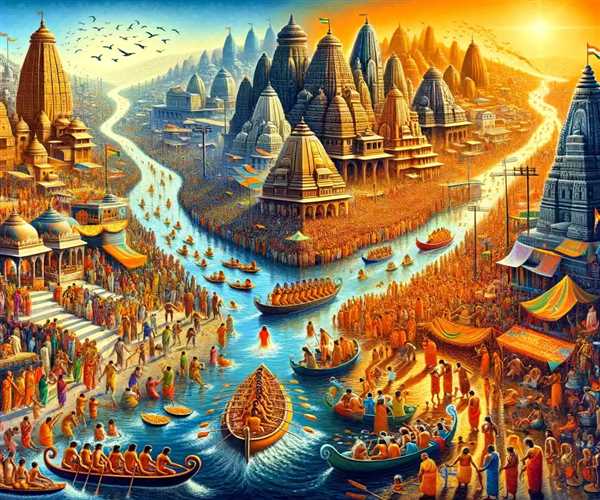Search here

03-Jul-2024 , Updated on 7/4/2024 4:15:29 AM
Maha Kumbha 2024 in Prayagraj: History and Importance
India is famous worldwide for its religion, history, culture, festivals, languages, and art. These elements make India vibrant and beautiful. Among the many cultural and religious fairs celebrated with immense joy are the Kumbh Mela, Sonepur Mela, Pushkar Mela, and Hemis. Today, we’ll dive into the biggest and most famous of them all: the Kumbh Mela.
The Kumbh Mela is celebrated with great enthusiasm and draws millions of visitors from India and abroad. It holds the title of the largest religious gathering in the world. At this fair, devotees take a holy dip in sacred rivers, believing this act cleanses their sins and grants them forgiveness for past mistakes. Those who bathe with true faith are said to gain freedom from the cycle of life and death. This makes the Kumbh Mela a significant pilgrimage event for Hindus.
The Kumbh Mela takes place at four locations: Prayagraj (where the Ganges and Yamuna rivers meet), Haridwar (on the banks of the Ganges), Nashik (on the banks of the Godavari river), and Ujjain (on the banks of the Shipra river). The timing and location of the Kumbh Mela are determined by the positions of the planets.
The Mythological Background of Kumbh Mela
The name "Kumbh Mela" might not be found in ancient texts, but the festival’s origins are deeply rooted in Hindu mythology. Historical texts call it the Magh Mela or Prayag Snan. According to ancient stories, kumbh refers to a pot filled with nectar. The name signifies a festival centered around this magical nectar.
One mythological story involves the Hindu sage Durvasa, who cursed the gods, making them weak and forcing them to live on Earth like ordinary humans. Meanwhile, demons took over the heavens. To regain their strength, the gods needed the nectar of immortality. With help from the demons, they churned the ocean to produce nectar. However, a conflict arose over who would get the nectar, leading to a chase that lasted 12 days (equal to 12 years for humans). During this chase, four drops of nectar fell to Earth, landing in the Ganges (Haridwar), the confluence of Triveni (Prayagraj), the Shipra River (Ujjain), and the Godavari River (Nashik). This myth is the basis for the Kumbh Mela, held every 12 years at these locations.
The Kumbh Mela has changed over time. The first mention of such bathing festivals is in the Rigveda, which refers to a sacred bathing festival at Prayag. Buddhist texts and the Mahabharata also mention similar festivals. Historical records from the time of the ancient Indian king Harsh, noted by the seventh-century Buddhist Chinese traveler Huan Tsang, describe Prayag as a city of temples where Hindus took holy dips in the confluence of rivers during the month of Magh.
Over time, the Magh Mela, celebrated annually at Prayag, gained importance. Other places like Nashik, Haridwar, and Ujjain also started holding similar bathing festivals. During the medieval period, texts like Ramcharitmanas and Ain-i-Akbari mentioned the Magh Mela. However, it wasn’t until the 19th century that the term "Kumbh Mela" was widely used. The British government recognized the popularity of the Magh Mela in Prayag and started calling other major fairs Kumbh Melas, giving them national and international recognition.
The Modern Importance of Kumbh Mela
Today, the Kumbh Mela is a huge event and a hub for Hindu culture and politics. It attracts millions of devotees, sadhus, saints, and members of various religious groups. Various programs, including community singing, spiritual discussions, and large-scale trading activities, are organized. The Kumbh Mela also played a significant role in India’s independence movement, with local leaders and pilgrims participating in efforts to abolish the pilgrim tax and resist forced conversions.
The economic impact of the Kumbh Mela is huge. For instance, the 2019 Ardh Kumbh in Allahabad saw the government spending Rs. 4200 crore on preparations, including the construction of a temporary city spanning 2500 hectares with 122,000 temporary toilets. The event attracted around 200 million people, significantly boosting local businesses and generating Rs. 1,000 crore in taxes for the UP government. Approximately 600,000 local jobs were created, boosting the local economy.
The Kumbh Mela has gained international recognition, with UNESCO including it in its Representative List of Intangible Cultural Heritage of Humanity. This festival, celebrated not only in Haridwar, Prayagraj, Ujjain, and Nashik but across India, has become a symbol of India’s rich cultural heritage. It showcases the country’s diversity, spirituality, and unity, drawing people from all walks of life.
According to me, the Kumbh Mela is not just a fair but a festival that embodies the essence of Indian culture. Its historical significance, mythological roots, and modern-day impact make it an integral part of India’s cultural landscape. As we celebrate the Kumbh Mela, let’s cherish and preserve this unique tradition, ensuring it continues to thrive for generations to come.

Student
I am a content writter !
Comments
Join Our Newsletter
Subscribe to our newsletter to receive emails about new views posts, releases and updates.
Copyright 2010 - 2025 MindStick Software Pvt. Ltd. All Rights Reserved Privacy Policy | Terms & Conditions | Cookie Policy